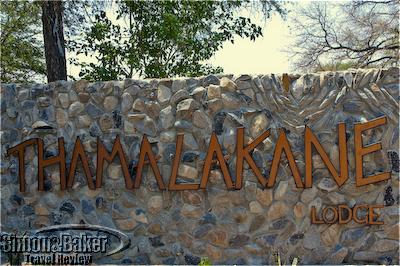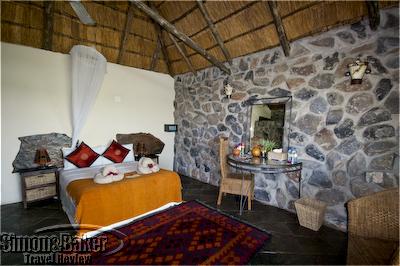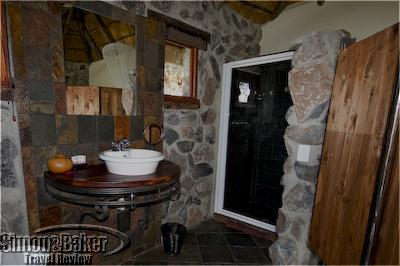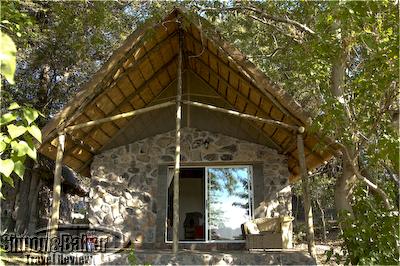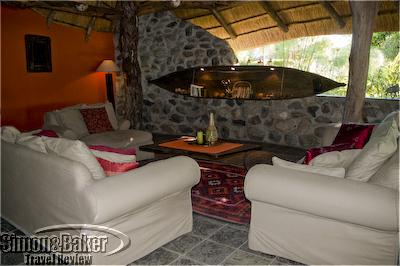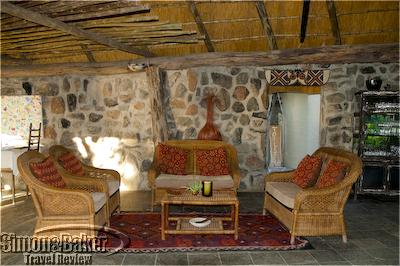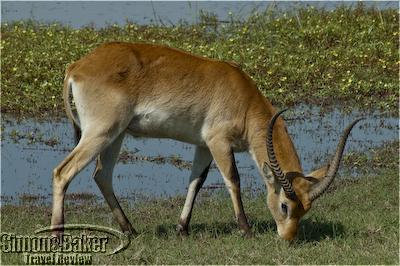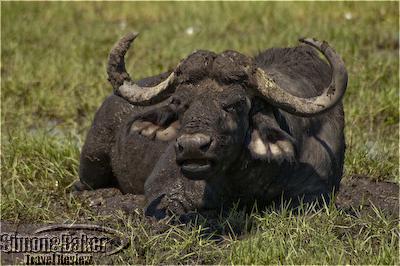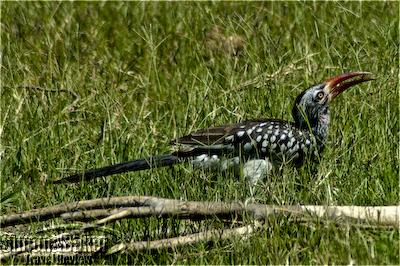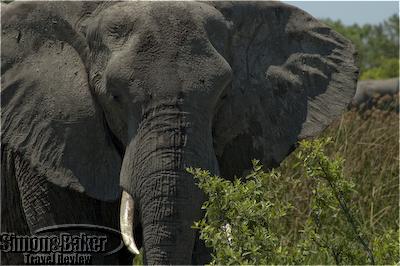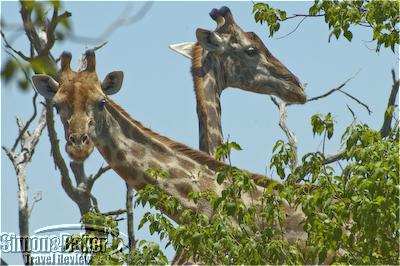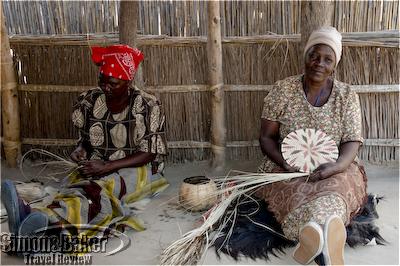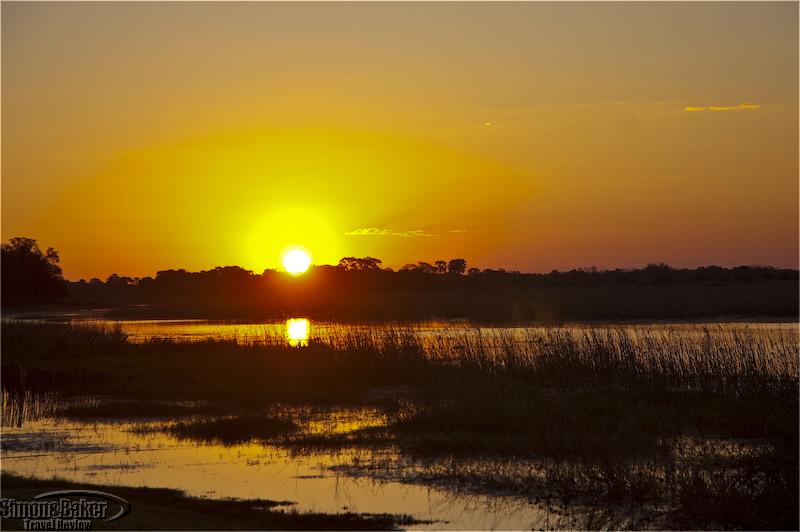
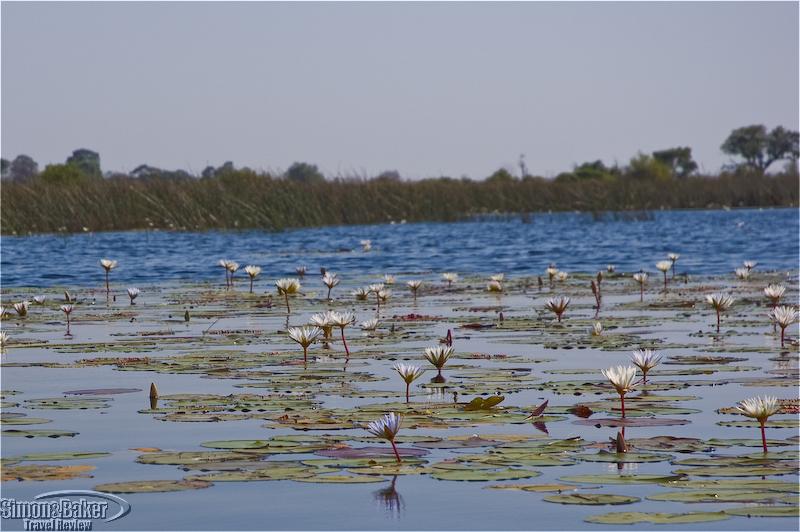
Thamalakane River Lodge was blessed with an exceptional location. Because of its proximity and easy access to Maun via a newly paved, four-lane road, this tranquil river retreat with decidedly urban touches (such as elegant à-la-carte international dining and thoughtful concierge services) appealed to the city’s elite as well as leisure visitors. For local residents, the lodge was a favored spot for business meetings and special-occasion dining. For safari tourists, it was a welcoming enclave of peace close to the city, to ease the transition to and from the bush or to settle in while exploring nearby eastern areas of the Okavango Delta. The latter was the purpose of my visit.
Working with a local safari tour company, the friendly staff of Thamalakane River Lodge arranged a program of activities tailored to my interests. A daylong excursion to the Moremi Game Reserve, a diverse environment of flood plain, permanent water, forest and savannah, made for outstanding game viewing. The next day found me cruising in a mokoro (flat dug-out canoe commonly used by local residents to move around the Okavango swamps) with my guide and pole man, across vast expanses of water lilies in full bloom and enjoying the exceptional bird life along the papyrus-bordered channels. I also visited Sexaxa, a nearby village of the local Bayei tribe. I spent a most rewarding morning there, not only exploring the cultural and domestic aspects of village life, but also communicating (through an interpreter) with several villagers who had as many questions about my world and daily life as I had about theirs.
With its easy proximity to Maun and the airport was well as the Moremi Game Reserve and the Okavango eastern flood plains, Thamalakane River Lodge was an ideal introduction to my visit of the Delta. Its superior accommodations, attentive management and well-trained staff made it a place where I will gladly return whenever tourism or business travel take me to the area in the future.
Communications Mobile phone service was readily available at the lodge as well as in and around Maun with GSM a 900/1800 compatible international cellular phone. A desktop computer connected to the internet was available for guest use in the reception area. Connectivity was erratic at best.
General Manager Jacques Van Der Merwe
Handicapped Access Motion impaired guests could be accommodated by previous arrangement.
Length Of Stay Four nights
Location On the Thamalakane River, a 20 minute drive northeast from Maun Airport, on the road to the Moremi Game Reserve.
On-Site Managers Tanja Von Kaschke and Neill Robberts
Owned The lodge was owned jointly by six private investors: Killor Ledimo, Robert Riggs, Jacques Van Der Merwe, and Sieg, Reinhardt and Marius Van Regburg.
Size The 21 acre (87,500 square meter) lodge consisted of 10 guest chalets capable of accommodating up to 20 guests. It employed a staff of 34 including two on-site managers.
Year Open-Renovated The property was built and began welcoming guests in 2007.
The library was in a quiet corner of the lounge. Its three overstuffed rolled-armed sofas angled around a wrought iron and slate coffee table were an especially cozy spot to settle with a book and a cool drink. An ancient wooden mokoro hung horizontally against the stone wall to provide an interesting sculptural shelf to store reading material. To the left of the entrance bridge, three steps led down to the dining room, which occupied the entire front of the lodge. Its square wrought iron tables were topped with slate. Matching metal chairs with high ladderbacks and coral canvas cushions provided the seating. Rough-hewn tree trunks supporting the roof served as backdrops for a collection of local masks and wood carvings. Beyond the dining room, square teak tables and armchairs were arranged around a tree-shaded flagstone terrace overlooking the river. The terrace was a popular spot for relaxed al fresco meals and sundowner drinks, as was the large boma (fenced flagstone terrace with an open air cooking area) at the far end of the dining room.
Room My 280 square foot (26 square meter) chalet, Number Five, featured a deep thatched covered veranda with a wicker loveseat and a small iron and slate coffee table. I especially enjoyed lingering there over my early morning coffee while observing the bird activity in the trees above. From the veranda, double sliding glass doors led into the chalet. Above them a triangular screened opening followed the pitch of the roof to ensure plentiful airflow. There was also a ceiling fan in the peak of the ceiling to keep the room comfortably cool at all times. The chalet was built of rustic stone. The back wall was white plaster with embedded slabs of slate that provided a visual headboard for the double bed. Two wood and wicker beside tables held reading lamps with beaded shade. Mosquito netting hung from a hoop above the bed. Furniture was made of local wrought iron. To the left of the door, a tall shelving unit provided storage and served as a luggage stand. In the center of the right wall, a half-round table topped with a large mirror and a high-back wicker chair served as a writing desk and dressing table. A wicker barrel armchair provided additional seating. At the foot of the bed, a large oriental throw rug covered the slate flooring. A stone and wood partition separated the sleeping area from the bathroom.
Gift Shop There was a small gift shop in the reception chalet. It carried a limited assortment of locally created crafts, mainly textiles, jewelry and basket wares.
Pool In the center of a well-kept lawn, a 20 by 20 foot (six by six meter) free form swimming pool was surrounded by six lounge chairs with natural canvas cushions. Under a matching canvas umbrella, six teak folding chairs arranged around a slate-topped coffee table provided additional seating. The attentive bar staff was prompt to deliver drinks and snacks, and constantly replenish the supply of pool towels.
Game I sighted included: black-backed jackal, elephant, zebra, giraffe, buffalo, hippo, red lechwe (including a startling snow-white albino specimen within a herd of its red brethren), tsessebe, steenbok, impala, waterbuck, kudu, red-painted frog.
Birds included: red eye dove, Cape mourning doves, swallow-tailed bee eater, carmine bee eater, red hornbill, gray hornbill, yellow hornbill, gray heron, saddle-billed stork, open-billed stork, slaty egret, gray egret, yellow-billed egret, little egret, blacksmith plover, lilac breasted roller, hadada ibis, sacred ibis, black-winged stilt, reed cormorant, African jacana, hammerkop, pygmy goose, African fish eagle.
With the exception of the general and on-site lodge managers, all staff was from the local community. Management and training programs were in place, and supervisory positions were being filled through promotion from within staff ranks. Local farmers had been contracted to organically grow produce for the lodge, thus ensuring top quality ingredients for the restaurant, while enhancing the relationship with the local community, and reducing the need for air-freighting food supplies (and the carbon footprint of the lodge). An effort was well underway to revert the landscaping of the grounds from exotic species to exclusively indigenous vegetation. In addition to its esthetic value, the new landscaping was resulting in a substantial reduction of ground upkeep and water consumption.
Date Of Last Visit October 2009
Reviewers Article and photographs by Josette King
Service The room was serviced once daily. All the staff I came in contact with had good English language skills, and were well trained, friendly and attentive.
Would You Stay There Again? Yes
Contact Information
- Sexaxa Ward
- PO Box 888
- Maun, Botswana
- +267 680 0217
- +267 7250 6184 (cell)
- +267 751 3300 (emergency)
- + 267 686 4313
